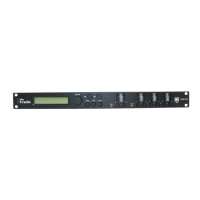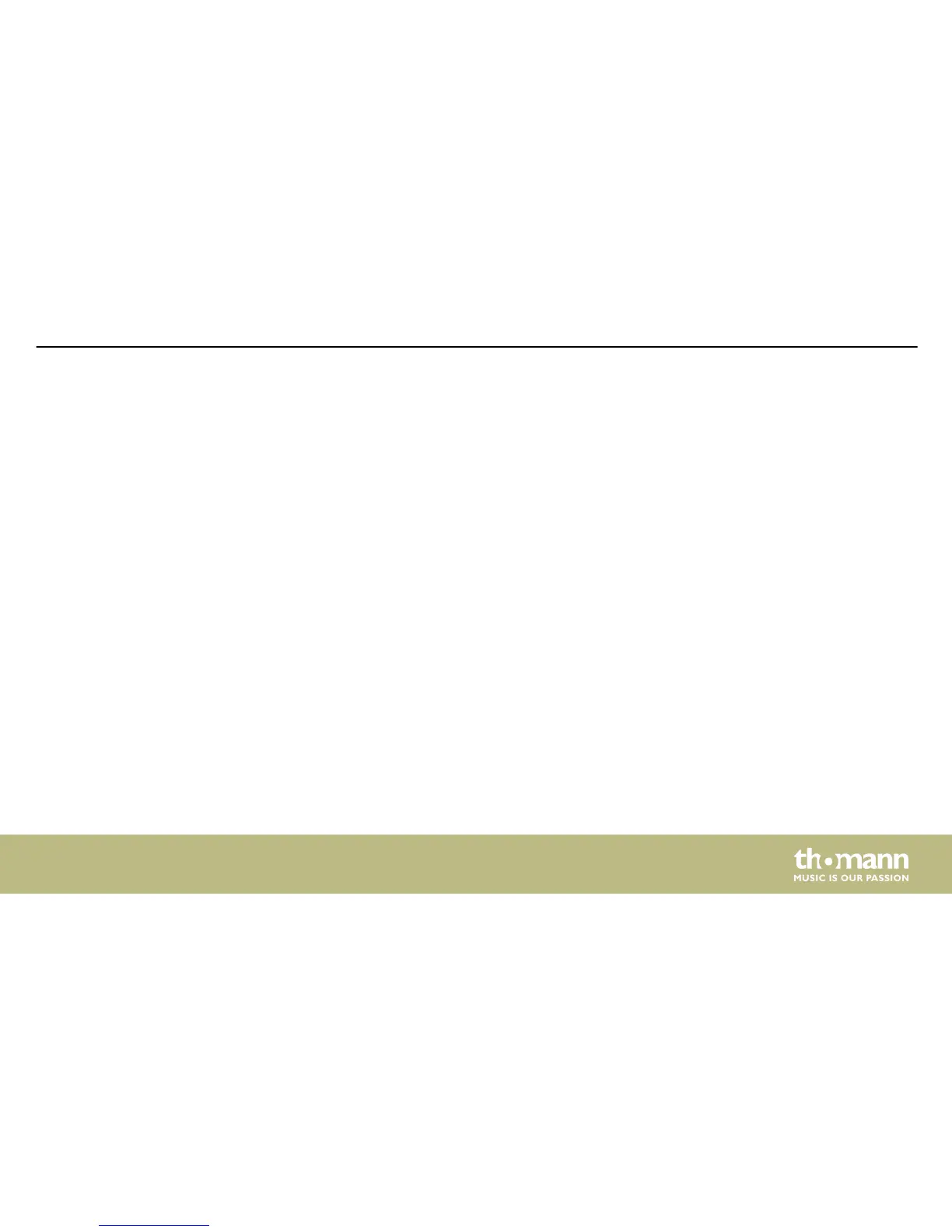

Do you have a question about the thomann T.racks DSP 26 and is the answer not in the manual?
| Outputs | 6x XLR |
|---|---|
| Dynamic Range | >110 dB |
| Delay | Yes |
| EQ | Yes |
| Crossover | Yes |
| Limiter | Yes |
| Display | LCD |
| PC Connection | USB |
| Power Consumption | 15 W |
| Model | T.racks DSP 26 |
| Sampling Rate | 48 kHz |
| Inputs | 2x XLR |
| Input Impedance | 10 kΩ |
| Frequency Response | 20 Hz - 20 kHz |
| THD+N | <0.01% |
| Bit Depth | 24 bit |
Details on accessing additional information via the website, including downloads and guides.
Explains symbols, text formatting, and cross-references used throughout the manual for clarity.
Overview of signal words (DANGER!, CAUTION!, NOTICE!) and their associated meanings for safety.
Illustrates warning signs for high-voltage and danger zones, clarifying potential hazards.
Defines the device's purpose and general safety precautions, including warnings for children.
Addresses risks of electric shock from high voltages inside and from short-circuits due to improper cabling.
Warns about potential hearing impairment from high volumes and risks of fire due to blocked ventilation or heat sources.
Covers safe operating conditions (indoor use) and power supply precautions, including voltage matching and storm safety.
Details the device's configuration of two input and six output channels.
Highlights the use of digital 24-bit processors and the inclusion of RS485 and USB interfaces.
Notes its design for standard 19-inch rack mounting, occupying one rack unit.
Provides instructions for installing the unit into a standard 19-inch rack.
Identifies and describes the controls and indicators on the front panel of the DSP 26.
Explains the functions of specific front panel elements like the display, rotary switches, and buttons.
Details the LED displays for input/output channels and the functionality of the USB port.
Identifies and describes the connectors and switches located on the rear panel.
Explains the function of rear panel elements such as the mains switch, IEC plug, and various I/O connectors.
Guides users on navigating the UTILITY menu for parameter adjustments.
Presents a visual overview of the options and flow within the UTILITY menu.
Details functions like Input Source, Noise Generator, and Link Input within System Utilities.
Explains linking and setting compressor/limiter parameters for output channels.
Covers adjusting delay units, resetting defaults, and viewing firmware version.
Instructions for recalling, saving, and deleting stored configurations (programs).
Covers interface setup (USB/RS485) and security options like parameter display and unit locking.
Details setting user passwords and enabling/disabling password protection for device access.
How to edit the name for input channels A or B.
How to adjust the noise gate settings for input channels.
How to adjust the input signal level for channels A or B.
How to invert the phase of the input signal for channels A or B.
How to adjust the runtime delay for input channels.
How to configure the compressor parameters for input channels.
How to bypass the equalizer and edit frequency range settings for input channels.
How to activate and adjust a dynamic filter for input channels.
How to edit the name for output channels 1 through 6.
How to assign input channels to output channels.
How to adjust the output signal level for channels 1 through 6.
How to invert the phase of the output signal for channels.
How to adjust the runtime delay for output channels.
How to configure compressor or limiter parameters for output channels.
How to adjust High Pass and Low Pass filters for output channels.
How to bypass the equalizer and edit frequency range for output channels.
How to activate and adjust a dynamic filter for output channels.
How to load and save channel presets for output channels.
Details input/output connectors, levels, and interface types.
Lists frequency response, SNR, converter bit depth, and sampling rate.
Provides information on supply voltage, fuse rating, dimensions, and weight.
Explains balanced vs. unbalanced transmission and their susceptibility to interference.
Details the pin assignments for both balanced and unbalanced XLR connectors.
Instructions for cleaning accessible device parts with appropriate cloths.
Guidelines for regular cleaning of fan grids to maintain airflow and prevent dust buildup.
Guidance on recycling and proper disposal of packaging materials.
Instructions for disposing of the old device according to WEEE and local regulations.